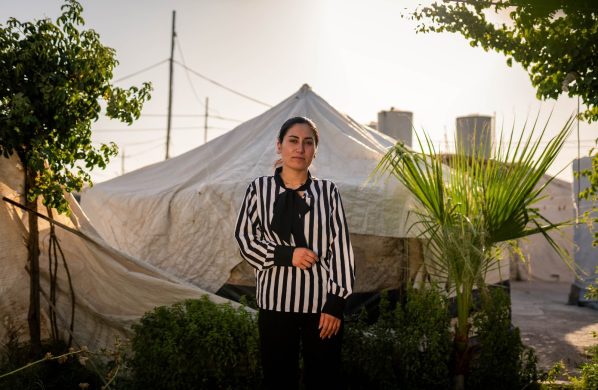Præsident Ali Abdullah Salah, ved magten i 32 år, anklages for korruption og favorisering af sin egen klan. Åben revolte i den sydlige del af landet og økonomiske protester i Sanaa.
SANAA, 8 February 2011 (IRIN) – In the past two weeks, Yemen has been rocked by some of the biggest anti-government demonstrations seen in a decade, as young people facing a grim economic future vent their frustration on the streets.
Drawing inspiration from uprisings in Tunisia and Egypt, thousands of people across Yemen have been taking to the streets to call for change in their country. On Thursday 3 February, around 20,000 protesters, mostly young men, occupied three major roads around the university in the capital, Sanaa. Large-scale protests also took place in other cities across Yemen, including Ibb and Taiz.
President Ali Abdullah Saleh has ruled Yemen for 32 years, first as president of North Yemen and then, after unification with South Yemen in 1990, as leader of the newly united republic. A series of pro-Saleh demonstrations have also taken place in Sanaa.
Widespread complaints
Saleh’s party, the General People’s Congress, holds a large majority in parliament, representing a “big tent” coalition. He also maintains an extensive informal patronage network of tribal leaders, businessmen and clerics.
At the beginning of January, Saleh proposed a constitutional amendment that would allow him to stand for re-election in the next presidential election in 2013.
The opposition coalition, which includes the Islamist party, Islah, as well as socialist and Nasserite parties, vehemently opposed the proposed amendment. Saleh, facing the prospect of major protests against his regime, said he would step down in 2013 and that his son, Ahmed, would not succeed him.
“No extension, no inheritance, no resetting the clock,” he said earlier this week, referring to ruling party proposals to abolish term limits that would have allowed him to run again. Constitutional amendments proposed by his party would also be frozen, and parliamentary elections scheduled for April 2011 would be delayed to allow for electoral reform.
After three decades in power, Saleh faces widespread complaints of corruption and the concentration of power within his tribal sub-group, the Sanhan clan.
Large areas of the country are already in open revolt against his regime, with a breakaway movement in the south, attacks on the security services by Al-Qaeda in the Arabian Peninsula (AQAP), and a de-facto semi-autonomous area in the north under the control of rebels.
Economic grievances
“Together we fight against poverty, corruption and injustice,” the protesters at Sanaa University chanted on Saturday 5 February, between intermittent bursts of music and speeches delivered by opposition politicians.
One banner hanging on the university gates read simply, “look at the gap between rich and poor”.
The mainstream media have focused largely on the political objectives of the protesters, some of whom are calling on President Saleh to step down, but many are calling for changes in their living standards as well as political reform.
For the average young Yemeni, the issues of daily life are far more important than politics. Graduates hope to find a job. Young men struggle to accumulate enough money to be able to get married. New couples battle with price hikes. Nearly half of the population lives on less than US$2 a day and social development indicators – such as child malnutrition, maternal mortality and educational attainment – remain extremely poor, according to the UN World Food Programme.
In the UN Human Development Index (HDI), Yemen is ranked at 138 out of 179 states listed.
Disenfranchised youth
“I came today because I had nothing else to do. I’d rather be here protesting than sitting on the roadside with my friends,” said Jamal Al-Fadli, 19, who scratches a living by ferrying people around Sanaa on his motorbike.
Nearly half the population of 23 million people are under the age of 15, and 70 percent are under 25, but over 50 percent of young people are unemployed and this number is expected to rise. The youth bulge represents a demographic and economic time bomb.
Yemen’s population is growing at a rate of 3.2 percent per annum, and is set to double by 2030.
“Our economy simply isn’t big or strong enough to provide enough jobs for such a rapidly expanding work force,” said Abdullah Al-Faqih, professor of political science at Sanaa University.
“The government has expanded universities and educated a swelling cohort of youth without laying the groundwork to employ them. The number of graduates has overwhelmed the government’s capacity to hire.”
Besides economic marginalization, young Yemenis also face social and political isolation. A 2008 US Agency for International Development study found that 40 percent of those interviewed expressed frustration, describing the Yemeni job market as one in which only those with connections and power could obtain decent employment.
Yemen’s young men and women often feel that social expectations are no longer achievable as a result of deteriorating economic and political conditions.
Yemen’s students
Students have played a major part in the demonstrations, and Sanaa University has become a hub for anti-government protests.
Saleh announced earlier this week that he would waive the remaining fees of this year for students enrolled in public universities. He also promised to establish a fund to create job opportunities for recent university graduates.
“Waiving tuition fees will not stop students from protesting – anyway, most of the students have already paid their fees,” said Rudhwan Masude, head of the student union at Sanaa University. “There just aren’t enough jobs to go round – the best students don’t think twice before leaving the country to seek work elsewhere.”
Students leaving secondary school complain they are not adequately prepared for the world of work.
“My school education was completely disconnected from the realities of employment. I was taught to memorize theoretical concepts, when I should have been learning English,” said Taha Al-Matari, a computer science student at Sanaa University.
“Our education system delivers quantity, but not quality.














